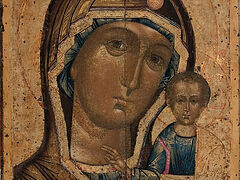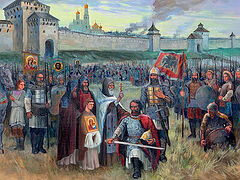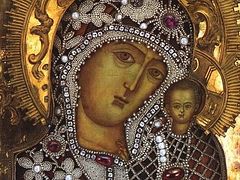On November 4 (October 22), the Church commemorates the Kazan Icon of the Mother of God. This icon is one of the most venerated sacred objects of Russia connected with the most important events in the history of the Russian state. Copies of the icon have been distributed across the country and many of them were glorified as miracle-working icons.
The commemoration of the Kazan Icon of the Mother of God began in Kazan, and it was celebrated on July 8 (21), the day of its finding. On October 22, 1612, during the battle of the Russian troops with the Poles in Moscow, a copy of this icon stayed with Prince Dmitry Pozharsky. Through the prayers and intercession of the Mother of God and the appearance of Her miracle-working Kazan icon, the Russian state was delivered from the Poles. Tsar Mikhail Feodorovich established a celebration in Moscow in memory of this event. In 1649, Tsar Alexei Mikhailovich, in memory of the birth of the heir on the feast day of the Kazan icon of the Mother of God ordered to hold celebrations on October 22 (November 4) throughout Russia.1
There are liturgical texts dedicated to every church feast. Troparions, or “verbalized” icons of the feast celebrated by the Church, hold a special place among them. We offer to our readers’ attention a theological and philological commentary of the main hymn of the feast.
In 1594, fifteen years after the appearance of the miracle-working icon, Metropolitan Hermogenes of Kazan—the future Patriarch of Moscow and All Russia, an eyewitness and participant of the finding of the icon, wrote the “Tale of the Appearance of the Kazan Icon.”2 This work was used in composing the troparion, which reads as follows:
“O fervent intercessor, Mother of the Lord Most High; thou dost pray for all before thy Son Christ our God, granting salvation to all who seek thy protection. O Queen and Sovereign Lady, protect us all, who in trouble and trials and sickness, and burdened with sins, stand in thy presence before thine icon, and who pray with compunction, contrition and tears and with unflagging hope in thee. Grant what is good for us, deliverance from evil, and save us all, O Virgin Mother of God, for thou art the divine protection to thy servants.”3
Translators of the divine service into Russian did not leave out the hymn so well known to the faithful. Thus, Archpriest Vladimir Ouspensky in the early twentieth century makes the following translation of the troparion:
“O earnest helper, Mother of the Lord Most High, thou dost entreat Christ, thy Son and our God, in behalf of all, and causest all to be saved who have recourse to thy mighty protection. O Lady, Queen and Mistress, help us all who, amid temptations, sorrows and sickness, are heavy laden with many sins, who stand before thee and with tears pray to thee with compunctionate soul and contrite heart before thine all-pure image, and who have unfailing hope in thee: Grant deliverance from all evils, and things profitable unto all, O Virgin Theotokos, and save us all, for thou art the divine protection of thy servants.”4
Fervent Intercessor
The Troparion begins with a lofty appeal of the Holy Hierarch Hermogenes that later came to be used in subsequent prayers to the Most Holy Mother of God.5 “Intercessor” means protectress, or patroness.6 That’s who the Most Holy Mother of God was in the days of Times of Troubles when the ruling tsarist dynasty in Rus was practically extinct and disorder broke out in the country. Fearing to remain forever under the rule of the Poles, the Russian people rose to the defense of their Motherland and placed their trust in the Heavenly Intercessor. They appealed to Her in prayer asking to help in their fight against the enemy. Afterwards, the Kazan icon becomes a symbol of love of the Russian people for the Mother of God.
Our сonfession
The phrase “thou dost pray for all before thy Son Christ our God” reminds us of the proper confession of Her as the Most Holy Mother of God. We believe and we confess that the Ever-Virgin Mary gave birth to Jesus Christ, the Son of God. Archimandrite Cyprian (Kern) explains our confession as follows:
The Mother of God “came out of midst worldly, sinful human beings, yet at the same time She is the Mother of God and a human being, and so it draws us intimately close to Her, brings Her closer to us, makes Her our intimate Intercessor, Advocate, so dear to us, Who understands and deigns to hear us.”7
During the final moments of His earthly life, Jesus Christ addresses His Most Pure Mother and points to His beloved disciple: Woman, behold thy son (John 19:26). With these words, the Lord adopts all of humanity to the Mother of God.
Causes all to be saved
“Thou causest all to be saved”; it is worth noting here that it is God Who saves. Only He can remove sin and free us from punishment for it (see: 2 Tim. 1:9; Tit. 3: 5). But the Most Holy Mother of God, through Her help and intercession, as Archpriest Vladimir Ouspensky correctly notes in his translation of the troparion, “causest all to be saved who have recourse to Her mighty protection.”
Compunctionate soul and contrite heart
It is the brokenness over our sins that contributes to the healing of the soul
A compunctionate soul, according to the Saint Ignatius (Brianchaninov), is a renewed soul in relation to God and eternity.8 A contrite heart is “a sorrowful and sad heart, the one that experiences or expresses contrition”9 over its many sins. One would think that a renewed soul and contrition contradict each other, but it is the contrition over sins that exactly contributes to the healing of the soul.
According to the teaching of the Holy Fathers, thanks to contrition of heart and tears, man learns to love God with all his heart and sees himself as the first among sinners. Such a man can join the Apostle Paul and say: Christ came into the world to save sinners; of whom I am chief (1 Tim. 1: 15).
Unflagging hope
Archpriest Vladimir Ouspensky translates the word unflagging as unfailing, that is, having no reason to be ashamed.10 The Psalmist proclaims: Put not your trust in princes, nor in the son of man, in whom there is no help (Psalm 146:3). We can’t say this about the Most Holy Mother of God, Who, according to another hymn to the Mother of God, is “support of the oppressed, the hope of the hopeless, intercessor of the poor, consolation of them that grieve, nourisher of the hungry, the raiment of the naked, the healing of the sick, the salvation of sinners, and help of all Christians.” 11
Divine Protection for Her servants
The appeal to the Mother of God should transform and uplift us so that we become worthy of Her help and protection
The idea of the protection of the Mother of God permeats the services to the Mother of God, both the sorrowful ones and those filled with joy. It is important to understand that our appeal to the Mother of God should transform and uplift us. In our prayer to Her, we should feel anguish over our sins, and reverence before Her, and gratitude for being vouchsafed Her help and protection.
Speaking about the fate of the Byzantine Empire in one of his sermons, the Holy Hierarch Innocent of Kherson said, “When the Mother of God saw that Her protection doesn’t make those whom She protects any better, that they don’t need Her mercy, but rather edifying punishment, She removed Her Protection.”12
The transformation of our lives according to the commandments of the Gospel is the crucial fruit of the prayer to the Mother of God. We, with our life, must bear witness before the world: the Most Holy Mother of God is our zealous Advocate and Sovereign Lady.




